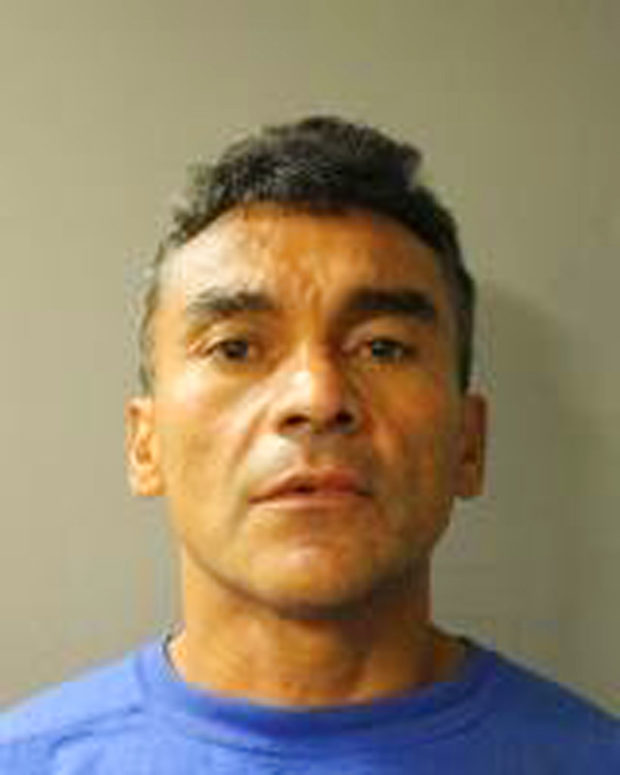
This photo provided by the Texas Department of Public Safety shows Ramon Escobar. Escobar, who was deported from the United States six times, was expected in court Wednesday, Sept. 26, 2018, to face charges after police say he killed three people and injured four in attacks targeting sleeping homeless men in California. Investigators believe Escobar began attacking the men at random on Sept. 8, shortly after he arrived in California from Houston, where he’s considered a person of interest in the disappearance of his uncle and aunt. (Texas Department of Public Safety via AP)
LOS ANGELES — A man with a violent criminal history who was deported six times had no outstanding warrants when questioned last month about the disappearance of his aunt and so he was released, Houston police said Wednesday, when the man was charged in Los Angeles with the beating deaths of three men.
Immigration records are generally not public, so it remained a mystery how Ramon Escobar, 47, won an appeal in immigration court in 2016 and why he remained free after a subsequent arrest for assault.
The Aug. 30 encounter by Escobar with Houston police came two days after his aunt vanished and marked his last brush with the law before his arrest in California this week.
Escobar was charged Wednesday in Los Angeles County with three counts of murder, five counts of attempted murder and four counts of second-degree robbery in attacks involving homeless men.
It could not be immediately determined if he had an attorney.
U.S. Immigration and Customs Enforcement said Escobar was ordered removed from the country by an immigration judge in February 1988, and he was deported to El Salvador six times between 1997 and 2011. He had six felony convictions for burglary and illegal re-entry.
The Board of Immigration Appeals granted his appeal in December 2016, and ICE released him a month later.
Last November, Escobar was arrested on the misdemeanor assault charge by Harris County, Texas, authorities, according to Texas Department of Public Safety records. He was convicted in May.
ICE spokeswoman Paige Hughes declined to comment on Escobar’s case beyond a statement issued late Tuesday. The Executive Office for Immigration Review, which oversees the immigration courts, did not provide information.
Andrew Arthur, a retired immigration judge, said the Board of Immigration Appeals may have allowed Escobar to stay in the country and be released under ICE supervision by granting him asylum or some other form of relief, like “withholding of removal” or protection under the United Nations Convention Against Torture.
“Even people with horrendous criminal records are able to access humanitarian relief to remain in the United States,” said Arthur, a fellow at the Center for Immigration Studies, which advocates for restrictions on immigration.
John Sandweg, a former acting director of ICE, said a serious criminal record can hurt an asylum claim but doesn’t disqualify someone from withholding of removal. Unlike asylum, withholding of removal does not include a path to citizenship and is therefore considered less appealing.
Escobar was questioned by Houston police on Aug. 30 in his aunt’s disappearance but police spokesman Kese Smith said he was not a suspect at the time. Investigators spoke with him because he was one of the last people to see Dina Escobar, 60, before she vanished in late August.
Her disappearance and that of her husband, Rogelio Escobar, 65, were considered missing-persons cases.
“We had no probable cause to arrest or book him,” Smith said Wednesday afternoon.
Immigration status is checked by Houston police only when a person is being booked into the city jail after being charged with a crime, Smith said.
Late Wednesday night, however, all that changed when Smith announced that foul play was now suspected in the disappearances.
Authorities say Escobar traveled to Los Angeles after the disappearances, of which he is now considered a person of interest.
Escobar likely targeted victims to rob them, according to Los Angeles police. He is being held without bail. He is believed to be the man captured on surveillance video ransacking the pockets and belongings of some downtown Los Angeles victims.
Detectives have seized a wooden baseball bat and bolt cutters that they believe were used to bludgeon men as they lay sleeping on the beach or on the street in Los Angeles and Santa Monica, police said. All but one of the men was homeless.
Two homeless men sleeping on the beach were bludgeoned in the head early on Sept. 8 and Sept. 10, leaving one in critical condition, officials said.
Another man who apparently was sleeping on the beach was found dead under the Santa Monica Pier on Sept. 20. Steven Ray Cruze Jr., 39, of San Gabriel, had been beaten to death.
Authorities at first described him as homeless, but family and friends said the father of two, who loved to fish at the pier, worked boats in neighboring Marina del Rey and sometimes camped out under the pier to avoid the long commute home. /jpv